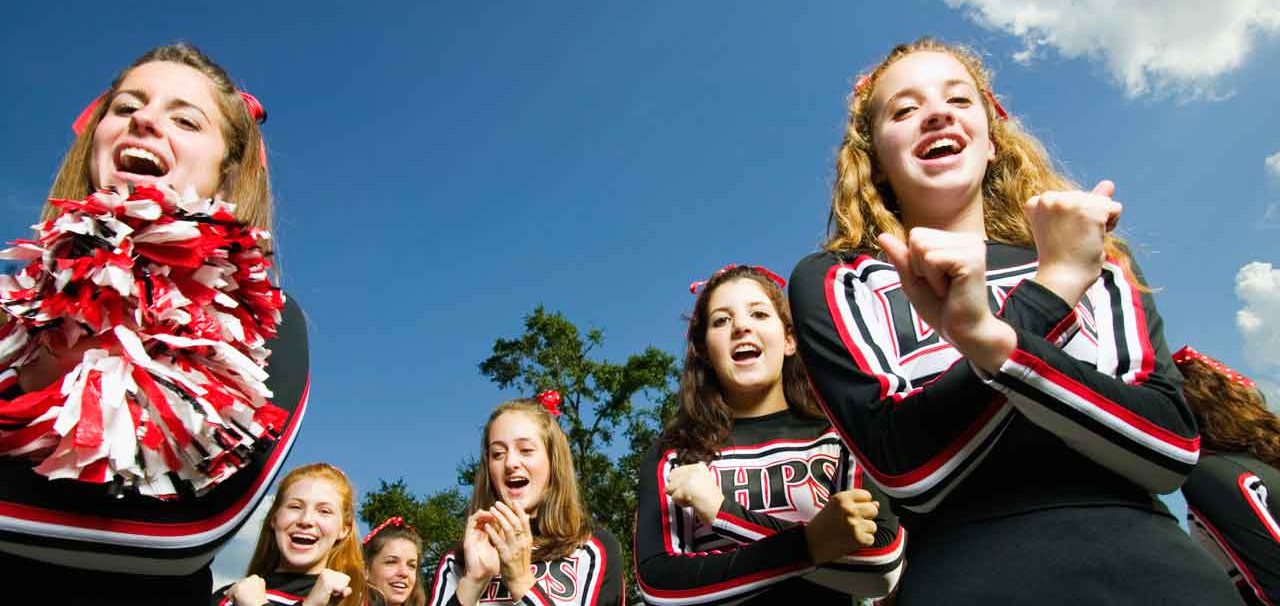Cheerleading Safety: Learn the Injuries and Risks

Cheerleading safety: Cheerleading isn’t associated with many accidents — but when injuries do occur, they can be serious.
Are your days of cheering for your school’s team far behind you, but your son or daughter is gung-ho about high school cheerleading? You should be aware cheerleading is far different from the pompom shaking, cartwheels, and cheering of past years. Today’s cheerleading is more athletic and involves jumps and complicated stunts seldom seen decades ago.
But despite cheerleading’s highly athletic moves, a study by a panel of health experts from Colorado University (CU) found cheerleading is among the safest of all high school sports activities. However, the researchers also found that cheerleading injuries have increased in recent years — and they can be serious.
YOU MIGHT ALSO LIKE: Are Female Teen Athletes at Risk for Injury?
Cheerleading injury statistics
The study involved injury reports from cheerleaders at 107 high schools over a period of five years. Out of a huge number of what the researchers call “athletic exposures” (cheerleading practices, competitions, and actual cheering at games), 752 female cheerleader injuries occurred. Male cheerleaders had a significantly higher injury rate; there were 25 injuries per 18,784 athletic exposures for teenage boys.
"We found that cheerleading is actually relatively safe compared to the other high school sports we studied, ranking 18th out of the 22 sports we looked at in terms of overall injury rate," said the study’s lead author, Dustin Currie, a doctoral student at the Colorado School of Public Health at CU Anschutz.
Although cheerleading's overall injury rate was significantly lower than the number of injuries in all other sports combined, that doesn’t mean there were no significant injuries. In fact, of the 22 sports studied, the researchers found cheerleading was second on the list of sports that caused injuries so severe youngsters missed at least three weeks of school.
The most common cheerleading injuries
The majority of injuries occurred while cheerleaders performed stunts, often during dismounts. Concussions were by far the most common type of injury — 30 percent involved this brain trauma. Ligament sprains, muscle strains, and fractured bones made up the rest of the cheerleading injuries. About four percent of the injuries, primarily for fractures and sprains, required surgery.
Although cheerleading has often been labeled a sideline activity to “real” sports, more than 400,000 students now participate in often complex and athletic cheerleading routines. One crucial way to make these activities safer is for states to classify cheerleading as a sport, according to the CU researchers.
Currently, however, high school athletic associations in each state in the U.S. decide whether cheerleading is considered a sport or treated as a club activity like a drama or chess club that involves no athletic activities.
“It is time that every state high school athletic association recognizes the vast majority of today’s high school cheerleaders are athletes,” said Dawn Comstock, PhD, associate professor of epidemiology at the Program for Injury Prevention, Education and Research at the Colorado School of Public Health.
“As athletes, cheerleaders should have access to the same safety standards as any other sport,” Currie added. “That means, for example, having a qualified coach present at every practice, a designated space in which to practice, and appropriate safety measures like mats and spotters when learning new skills.”
Cheerleading safety and the AACCA
The American Association of Cheerleading Coaches and Administrators (AACCA) is also concerned about the safety of cheerleaders, but has taken a different stance. In a position paper, the organization opposes designating cheerleading as a sport. Instead, the AACCA says cheerleading should be put in a developing category called "athletic activity,” which includes other non-competition activities like dance and drill teams and marching bands.
Some states now officially recognize cheerleaders as "student athletes,” making them eligible for academic honors. The designation may also help cheerleaders receive coverage under athletic catastrophic insurance policies carried by their schools or state athletics or activities associations, according to the AACCA.
To help you know whether your cheerleading youngsters are protected from unreasonable risk, the AACA advises talking to the school’s cheerleading coach about safety. And, if you have questions that aren’t answered, contact the school administration and find out if the cheerleading squad has an emergency plan in place to provide a quick response if there’s an accident at practice or a game. A sample emergency plan is available for download from the AACA.
Visit STOP (Sports Trauma and Overuse Prevention) Sports Injuries, an on-line outreach program created by the American Orthopaedic Society for Sports Medicine, for more information and tips to help parents, youngsters, and coaches prevent cheerleading injuries.
Updated:
February 27, 2020
Reviewed By:
Janet O’Dell, RN